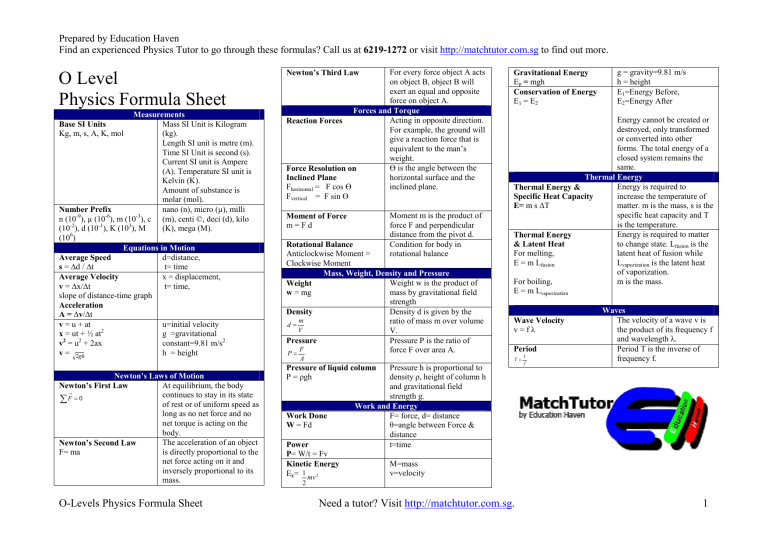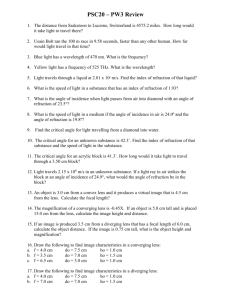
Prepared by Education Haven Find an experienced Physics Tutor to go through these formulas? Call us at 6219-1272 or visit http://matchtutor.com.sg to find out more. O Level Physics Formula Sheet Measurements Mass SI Unit is Kilogram (kg). Length SI unit is metre (m). Time SI Unit is second (s). Current SI unit is Ampere (A). Temperature SI unit is Kelvin (K). Amount of substance is molar (mol). nano (n), micro (µ), milli Number Prefix n (10-9), µ (10-6), m (10-3), c (m), centi ©, deci (d), kilo (10-2), d (10-1), K (103), M (K), mega (M). (106) Equations in Motion d=distance, Average Speed s = ∆d / ∆t t= time x = displacement, Average Velocity v = ∆x/∆t t= time, slope of distance-time graph Acceleration A = ∆v/∆t v = u + at u=initial velocity x = ut + ½ at2 g =gravitational v2 = u2 + 2ax constant=9.81 m/s2 h = height v = 2gh Base SI Units Kg, m, s, A, K, mol Newton’s Laws of Motion At equilibrium, the body Newton’s First Law → continues to stay in its state ∑F = 0 of rest or of uniform speed as long as no net force and no net torque is acting on the body. The acceleration of an object Newton’s Second Law F= ma is directly proportional to the net force acting on it and inversely proportional to its mass. O-Levels Physics Formula Sheet For every force object A acts on object B, object B will exert an equal and opposite force on object A. Forces and Torque Acting in opposite direction. Reaction Forces For example, the ground will give a reaction force that is equivalent to the man’s weight. Ө is the angle between the Force Resolution on horizontal surface and the Inclined Plane inclined plane. Fhorizontal = F cos Ө Fvertical = F sin Ө Newton’s Third Law Moment m is the product of force F and perpendicular distance from the pivot d. Condition for body in rotational balance Moment of Force m=Fd Rotational Balance Anticlockwise Moment = Clockwise Moment Mass, Weight, Density and Pressure Weight w is the product of Weight w = mg mass by gravitational field strength Density d is given by the Density m ratio of mass m over volume d= V V. Pressure P is the ratio of Pressure F force F over area A. P= A Gravitational Energy Ep = mgh Conservation of Energy E1 = E2 Energy cannot be created or destroyed, only transformed or converted into other forms. The total energy of a closed system remains the same. Thermal Energy Energy is required to Thermal Energy & increase the temperature of Specific Heat Capacity E= m s ∆T matter. m is the mass, s is the specific heat capacity and T is the temperature. Energy is required to matter Thermal Energy to change state. Lfusion is the & Latent Heat For melting, latent heat of fusion while E = m Lfusion Lvaporization is the latent heat of vaporization. For boiling, m is the mass. E = m Lvaporization Wave Velocity v=fλ Period T= Pressure h is proportional to density ρ, height of column h and gravitational field strength g. Work and Energy F= force, d= distance θ=angle between Force & distance t=time Pressure of liquid column P = ρgh Work Done W = Fd Power P= W/t = Fv Kinetic Energy Ek= 1 mv 2 g = gravity=9.81 m/s h = height E1=Energy Before, E2=Energy After 1 f Waves The velocity of a wave v is the product of its frequency f and wavelength λ. Period T is the inverse of frequency f. M=mass v=velocity 2 Need a tutor? Visit http://matchtutor.com.sg. 1 Prepared by Education Haven Find an experienced Physics Tutor to go through these formulas? Call us at 6219-1272 or visit http://matchtutor.com.sg to find out more. Light and Optics The angle of incident Ө1 is equal to the angle of reflection Ө2. Both are θ1 = θ 2 with respect to the perpendicular normal of the surface of the mirror. The angle of incident Ө1 and angle Snell’s Law of refraction Ө2 is with respect to (refraction) the perpendicular normal of the n1 sin θ1 = n2 sin θ 2 surface between the two medium. The critical angle θc is the angle of Critical Angle incidence beyond which total n sin θ c = 2 internal reflection occurs. The index n1 of refraction for the medium in which the incident ray is traveling is n1, the index of refraction for the second medium which the refracted ray is traveling is n2. Index of Refraction The higher the index of refraction is for a medium, the slower is the c speed of light v in the medium. c is n= v the speed of light in vacuum. The Lens Equation The focal length of the lens f is: • Positive for a converging 1 1 1 + = lens do di f • Negative for a divergent lens The object distance do is: • Positive if it is on the side of the lens from which the light is coming • Negative if on the opposite side Law of Reflection Magnification m= hi d =− i ho do The image distance di is: • Positive if it is on the opposite side of the lens from which the light is coming • Negative if on the same side For an upright image, the magnification m is positive and for an inverted image m is negative. O-Levels Physics Formula Sheet For a spherical mirror, the focal length is half of the radius of curvature. Focal Length of a mirror f = 1 r 2 Transformer Current I = ∆C / ∆t Ohm’s Law Resistance R=V/I Resistance of a wire R = ρL/A Electric Power P = VI = V2/R = I2R Electronic Circuits C=Charge t=time V=voltage, R= resistance, I = current ρ = resistivity L = length of wire A = cross sectional area Combining ohm’s law the power P can be calculated using any combination of these three equation variations. Electrical Energy E = Pt = VIt Root Mean Square Voltage & Current & Power Vo I , I rms = o 2 2 I 2R 1 2 = I rms R= 0 = P 2 2 Vrms = Prms Resistance in Series Rtotal = R1 + R2 + R3 Resistance in Parallel 1 1 1 1 = + + Rtotal R1 R2 R3 Kirchoff’s First Law inco min g ∑I = outgoing ∑I Kirchoff’s Second Law Electrical energy can be calculated by the product of power and time. For an AC circuit, the root-meansquare (rms) values can be calculated from the peak values. Prms= 0.5 Pmax Resistance in series adds up. Having more obstacles along the path for current means more resistance. Resistance in parallel takes the reciprocal. Parallel path for current to go through means lesser resistance. Sum of all incoming currents at a junction is the same as sum of all the outgoing current at a junction. supplied by the power supply. ∑V = EMF Vp Vs = np ns Electromagnetism The ratio of the voltage Vp and Vs in a transformer is proportional to the ratio of the number of coils np and ns. Right Hand Grip Rule I is the current. B is the magnetic field. Fleming’s Left Hand Rule (Motor Rule) Thumb is for the motion. Index finger is for the magnetic field. Second finger is for the current. Fleming’s Right Hand Rule (Generator) Thumb is for the motion. Index finger is for the magnetic field. Second finger is for the current. Sum of all potential difference V in components of a circuit is equal to the electromotive force EMF Need a tutor? Visit http://matchtutor.com.sg. 2





